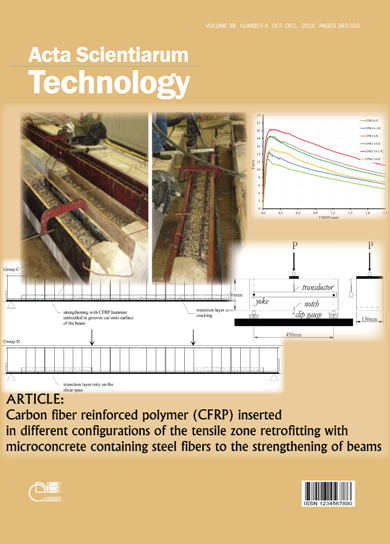<b>Basalt waste added to Portland cement
DOI:
https://doi.org/10.4025/actascitechnol.v38i4.27290Palavras-chave:
mineral admixture, particle size, microstructure, nucleation.Resumo
Portland cement is widely used as a building material and more than 4.3 billion tons were produced in 2014, with increasing environmental impacts by this industry, mainly through CO2 emissions and consumption of non-removable raw materials. Several by-products have been used as raw materials or fuels to reduce environmental impacts. Basaltic waste collected by filters was employed as a mineral mixture to Portland cement and two fractions were tested. The compression strength of mortars was measured after 7 days and Scanning Electron Microscopy (SEM) and Electron Diffraction Scattering (EDS) were carried out on Portland cement paste with the basaltic residue. Gains in compression strength were observed for mixtures containing 2.5 wt.% of basaltic residue. Hydration products observed on surface of basaltic particles show the nucleation effect of mineral mixtures. Clinker substitution by mineral mixtures reduces CO2 emission per ton of Portland cement. Â Â
Downloads
Downloads
Publicado
Como Citar
Edição
Seção
Licença
DECLARAÇíO DE ORIGINALIDADE E DIREITOS AUTORAIS
Declaro que o presente artigo é original, não tendo sido submetido í publicação em qualquer outro periódico nacional ou internacional, quer seja em parte ou em sua totalidade.
Os direitos autorais pertencem exclusivamente aos autores. Os direitos de licenciamento utilizados pelo periódico é a licença Creative Commons Attribution 4.0 (CC BY 4.0): são permitidos o compartilhamento (cópia e distribuição do material em qualqer meio ou formato) e adaptação (remix, transformação e criação de material a partir do conteúdo assim licenciado para quaisquer fins, inclusive comerciais.
Recomenda-se a leitura desse link para maiores informações sobre o tema: fornecimento de créditos e referências de forma correta, entre outros detalhes cruciais para uso adequado do material licenciado.



















